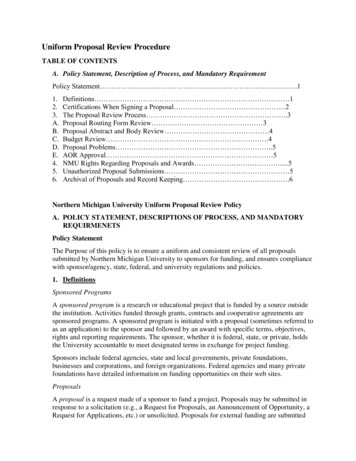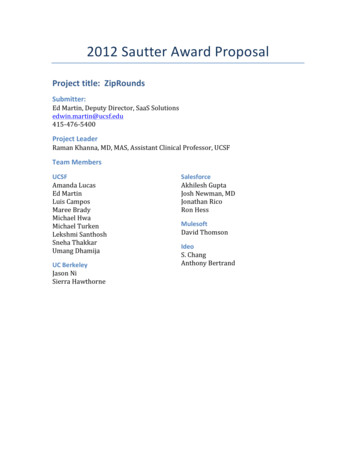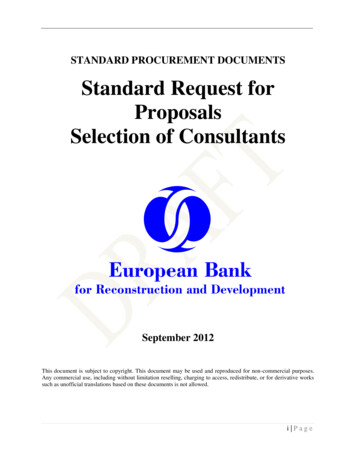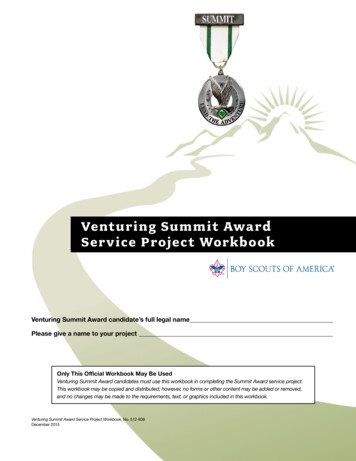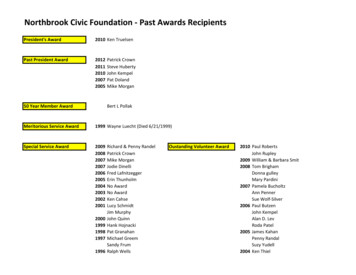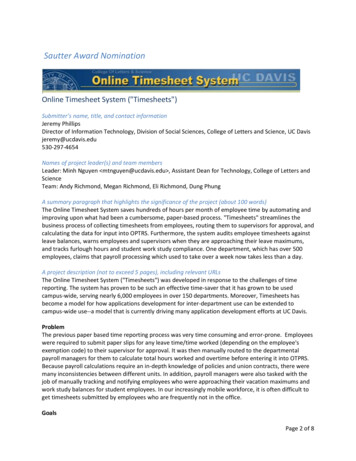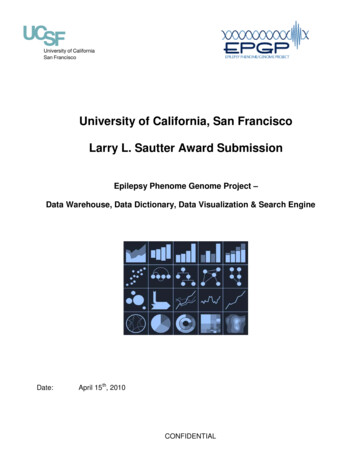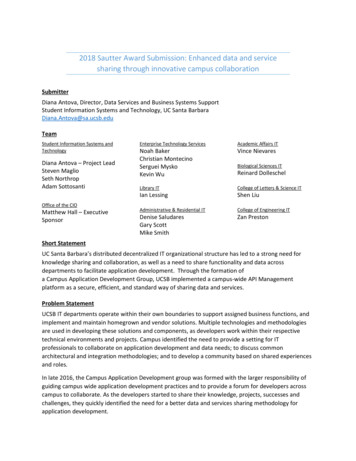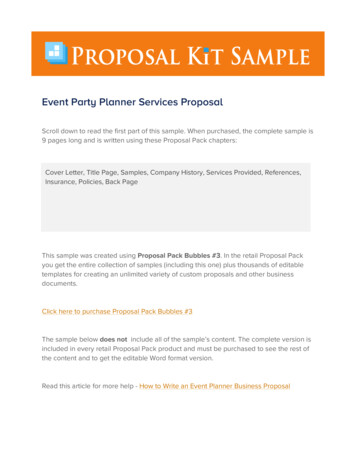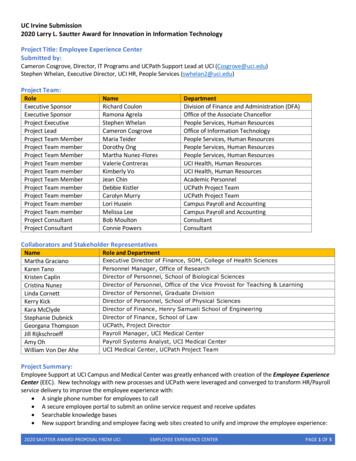
Transcription
UC Irvine Submission2020 Larry L. Sautter Award for Innovation in Information TechnologyProject Title: Employee Experience CenterSubmitted by:Cameron Cosgrove, Director, IT Programs and UCPath Support Lead at UCI (Cosgrove@uci.edu)Stephen Whelan, Executive Director, UCI HR, People Services (swhelan2@uci.edu)Project Team:RoleExecutive SponsorExecutive SponsorProject ExecutiveProject LeadProject Team MemberProject Team memberProject Team MemberProject Team memberProject Team memberProject Team MemberProject Team memberProject Team memberProject Team memberProject Team memberProject ConsultantProject ConsultantNameRichard CoulonRamona AgrelaStephen WhelanCameron CosgroveMaria TeiderDorothy OngMartha Nunez-FloresValerie ContrerasKimberly VoJean ChinDebbie KistlerCarolyn MurryLori HuseinMelissa LeeBob MoultonConnie PowersDepartmentDivision of Finance and Administration (DFA)Office of the Associate ChancellorPeople Services, Human ResourcesOffice of Information TechnologyPeople Services, Human ResourcesPeople Services, Human ResourcesPeople Services, Human ResourcesUCI Health, Human ResourcesUCI Health, Human ResourcesAcademic PersonnelUCPath Project TeamUCPath Project TeamCampus Payroll and AccountingCampus Payroll and AccountingConsultantConsultantCollaborators and Stakeholder RepresentativesNameMartha GracianoKaren TanoKristen CaplinCristina NunezLinda CornettKerry KickKara McClydeStephanie DubnickGeorgana ThompsonJill RijkschroeffAmy OhWilliam Von Der AheRole and DepartmentExecutive Director of Finance, SOM, College of Health SciencesPersonnel Manager, Office of ResearchDirector of Personnel, School of Biological SciencesDirector of Personnel, Office of the Vice Provost for Teaching & LearningDirector of Personnel, Graduate DivisionDirector of Personnel, School of Physical SciencesDirector of Finance, Henry Samueli School of EngineeringDirector of Finance, School of LawUCPath, Project DirectorPayroll Manager, UCI Medical CenterPayroll Systems Analyst, UCI Medical CenterUCI Medical Center, UCPath Project TeamProject Summary:Employee Support at UCI Campus and Medical Center was greatly enhanced with creation of the Employee ExperienceCenter (EEC). New technology with new processes and UCPath were leveraged and converged to transform HR/Payrollservice delivery to improve the employee experience with: A single phone number for employees to call A secure employee portal to submit an online service request and receive updates Searchable knowledge bases New support branding and employee facing web sites created to unify and improve the employee experience:2020 SAUTTER AWARD PROPOSAL FROM UCIEMPLOYEE EXPERIENCE CENTERPAGE 1 OF 5
https://eec.hr.uci.edu/ and https://ucpath.uci.edu/Project NarrativeThe Situation and Problem Statement:Before the solution, service delivery for employees had evolved organically over the history of the campus and locallythroughout various departments. Campus HR support has a centralized component along with decentralized HR withineach division (School). Central Campus HR accepted requests across 10 email boxes and direct emails/phone calls tosubject matter experts. Medical Center used the campus centralized HR service and their own centralized Payrollservice. Campus Payroll had its own centralized support email boxes and phone number.Without re-organizing or centralization of the decentralized HR and payroll functions, UCI leadership wanted theemployee support experience to be easy to find, scalable, sustainable, consistent, professional, a focus on firstcall/contact resolution where possible; including well organized support cases tracked with metrics. Leadership, also,wanted to re-align the way support is provided at UCI with the UCPath system and UCPath Service Center to ensureemployees get support without adding extra steps, delays, unnecessary hands-off and finger pointing.Project Solution:The solution unified over 60 support services and linked processes across both centralized HR and Payroll, decentralizedHR specialists on Campus as well as the support Medical Center teams. The new service delivery design incorporatedhow local UCI UCPath support operates in alignment with the UCPath Support Center.By using a new (enterprise wide) case management platform (ServiceNow Enterprise HR Module) we were able to unifyall the teams with a single “pane of glass” view of the entire Campus and Medical Center. The ServiceNow Enterprise HRmodule was specifically configured to bring together all UCI HR and Payroll support departments, teams and individualswith unified case in-take, triage, prioritization, communication, case status and a single source of truth for support casemetrics.The Campus OIT team built integrations with UCPath in such a way that employee profile and organizational hierarchiesare imported into the ServiceNow HR module daily. This way all the data in ServiceNow was up to date and accurate.This data schema is leveraged to provide access permissions with granular controls to prevent decentralized teams fromseeing any information outside of their division. This is leveraged equally by the ITSM Modules used by OIT and greatlyeased our transition into UCPath as well.The main innovation was not the technology, but the collaborative service delivery design process and establishing thenew support team called the Employee Experience Center (EEC). The EEC is housed in the Central Campus HR area astier 1 or primary in-take for all Campus and Medical Center support issues; especially issues and questions arising fromUCPath for pay and benefits. The EEC is the primary conduit and point of contact to the UCPath Service Center. Thereare many benefits realized from of this new support model:1. Transforming the entire organization into a single support taxonomy with well-organized and socialized method ofcollecting and triaging all issues and questions about pay, benefits, UCPath and general inquiries. This transitionenabled Campus and Medical Center service providers to focus on request fulfillment and issue resolution whileleveraging the same terminology, process flows, data and case management system.2. The EEC is scalable and provides transparency on all support issues across the enterprise. This paid huge dividendswhen UCI converted to UCPath; as well as UCI’s single COVID-19 point of contact for inquiries and information. Withthe EEC Model and Case management platform, we could monitor the entire enterprise in real time and reallocateresources to special needs as they arise. All issues and questions were captured in thousands of cases withcomplete (real time) transparency to leadership and the UCPath Service Center. Management had real-time access2020 SAUTTER AWARD PROPOSAL FROM UCIEMPLOYEE EXPERIENCE CENTERPAGE 2 OF 5
3.4.5.6.to issue trends through customized team dashboards. UCI’s transition to UCPath is considered a success, in part, tothe new support model, case management platform and teaming across the enterprise.All support providers are on equal footing – and fully supported, so that we became one big team. The culture wasabout owning our situations and working better together to solve them without finger pointing. It was observedmultiple times by the members of the UCPath Service Center (UCPC) that were on-site at time of conversion toUCPath, that “UCI’s teamwork is exceptionally strong”.When State mandated COVID-19 rules and the shift to working remote, the teams were easily able to make theshift—with the model and service platform keeping us all connected and UCI was able to expand services beyondemployees, and support our students and parents at a very critical time. .The EEC model is sustainable and will grow over time to encompass more services such as onboarding, EmployeeWorkforce Relations, employee engagement and training.Case Management Platform (Service-Now HR Module) Dashboards keeps the EEC, stakeholders and leadershipinformed and focused:CollaborationExtreme collaboration across the entire campus community and medical center was required to facilitate deepdiscussions and reviews of decades old processes, individual roles and come to agreement on proposed changes toimprove and realign. To create the future state service delivery design, 9 months of stakeholder meetings wereconducted weekly to hear the “voice of the customer” and understand the current support scope of work performedthroughout Campus and Medical Center. With this deep level of collaboration we were able to design processes thatwere flexible enough to meet a diverse set of local needs, and yet, have a common foundation for implementationwithin an Enterprise wide Case Management Platform. In short, all Campus and Medical Center service owners were onboard with the future state and new case management platform, including buy-in for the new processes they wouldperform daily.Overcoming the status quo was not easy. Aligning around a new model to work together on a common platform andintegrating UCPath business processes and system changes was an achievement of teamwork and commitment to thecommon objective of providing all UCI employees with the level of service they deserve.Project Timeline:UCI went live with UCPath on January 2, 2020. We started the Collaborative Stakeholder meetings in March of 2019.By the time the stakeholder alignment process and tool selection was complete, it was August of 2019—time wasrunning out to implement this new case management platform along with dozens of new support processes, rolechanges that also had to align with additional hiring and training. The goal was to have everything in place includingnew employees for the EEC team hired, trained and ready to go in early December 2019 in order to pilot the newprocesses and Service-Now HR module a few weeks before the UCPath go-live. It was game on. Everyone pulled2020 SAUTTER AWARD PROPOSAL FROM UCIEMPLOYEE EXPERIENCE CENTERPAGE 3 OF 5
together to meet our timeline. The EEC went live on December 9th. Training was significant and spanned multiplemonths starting in October 2019.11/22/20198/1/20192/4/2019Begin On-GoingLeadershipAlignmentCase ManagementConfiguration Start5/31/2019Vendor RFP Complete4/1/20191/1/201910/7/2019EEC Staff10 week te1/2/2020EEC Live12/12/2019EEC Pilot1/1/20201/2/20202/15/2019 - 7/31/2019Process Requirements Gathering2/25/2019 - 11/29/2019Stakeholder Alignment and Service Delivery DesignImpactThis project is a prime example of how technology enables people and process. The people and processes are thecenterpiece of all the results achieved. The EEC completed their pilot and was fully operational on same day UCI wentlive with UCPath. The EEC was the focal point for collecting, triaging and assigning all issues. The EEC was taking over ahundred of calls a day and a remarkable 30% of the cases opened were created by the employees on the self-serviceportal. With detailed case information the team was able to work effectively with employees and the UCPath Center.With full visibility into all open issues teams, managers and top leadership were informed in real time.Measures of SuccessThere were two objectives of the Employee Experience Center and ServiceNow HRSD platform. The first was to create aone stop shop at UCI where we can effectively communicate how UCI employees get assistance. The second was tointegrate each of UCI’s service departments, thus avoiding the need to create a massive support team, but to theemployee requesting a service we appear as one. By accomplishing these objectives, we have created the bestemployee experience possible. UCI’s Employee Experience Center:1. Provides consistent information and services by a dedicated tier 1 team2. Is a simple one stop shop and employees know where to go3. Is seamless, despite the back end integration of 100’s departments, 30 divisions, and three businessunits4. Keeps local issues local5. Eliminates unnecessary handoffs, replication of work and drain on resources, including the employee6. As needed, ensures UCPath issues are resolved timely, and UCI employees have access to UCI subjectmatter experts for critical pay and benefit issues7. Does not replicate the business processes that the UCPath Center owns but adds value if an employeecontacts the EEC for a UCPath related transaction. Under these circumstances the EEC will set employeeexpectations, provide guidance as needed and direct them to the UCPath Center. We believe settingthe employee expectations (e.g., call wait times, recommending employee self-service, UCPath servicelevel agreements, required documents needed etc.), increased the likelihood of a more positive andeffective UCPath Center/employee experience.There were a great deal of unknowns at the time of UCPath go-live given the unique relationship with a semi-outsourcedHR system, and the unique experiences of each UC that went before UCI. However, our measure of success was to giveour employees the best employee experience possible, adapt our support model effectively and efficiently as moreinformation became available, and realize employee self-service numbers of about 30% for this new service andtechnology. In this early phase, we have considered the effort a success with the following accomplishments:2020 SAUTTER AWARD PROPOSAL FROM UCIEMPLOYEE EXPERIENCE CENTERPAGE 4 OF 5
1. Prior to UCPath go-live there was not a single source to capture general, pay and benefit relatedinquires, and now since UCPath go-live we have received over 7,500 calls and 10,000 inquiries throughMarch 2020.2. Latest employee survey rates the EEC’s ease of use at 4.8 of 5 and overall experience is 4.28 of 5.3. In 24 hours we configured the EEC model to support a dedicated OCVID-19 line, and expanded ourservices to concerned students and parents.4. Overall employee self-service is 34.2% since go-live and was 45.4% in March.There was a great deal of work in the preparation for go-live, however, it is truly just the beginning. Over the course ofthe next 18 months we’ll continue to expand our services, optimize our business flows, add automated life cycle events,incorporate chat and release a native mobile app.TechnologyThese are the foundational technology products used by the EEC: ServiceNow Enterprise HR Module Mitel Call Center AgentIn addition, the office of technology provided integrations to UCPath and the Operational Data Store (ODS) toprovide employee profile and organizational structure information with mapping to ServiceNow HR Module.Significant amount of work went into the ServiceNow HR module configuration and implementation. Over 60new services were defined and dozens of assignment groups created for service providers to organize theirincoming cases.A pleasant surprise was the high level of adoption by employees of the self-service portal. ServiceNow initiallyrecommended that we wait on the portal for a year post go-live to give the employee population time toadjust to the new service delivery model. We decided that part of the value of the new platform is self-serviceand part of our guiding principles is scalability—so despite our tight implementation timeline—we rallied ourteam to implement the self-service portal. Within the first month we had over 30% of our daily cases createdby employees. By the second month, there were peak days of 45% created on the portal. By the third monthour average self-service cases were in the 40% range with peaks as high as 60%.We believe the high rate of employee adoption was directly related to the ease of use, a large service catalogand the creation of over 100 knowledge articles.2020 SAUTTER AWARD PROPOSAL FROM UCIEMPLOYEE EXPERIENCE CENTERPAGE 5 OF 5
throughout various departments. Campus HR support has a centralized component along with decentralized HR within each division (School). Central Campus HR accepted requests across 10 email boxes and direct emails/phone calls to subject matter experts. Medical Center used the campus centralized HR service and their own centralized Payroll service.
